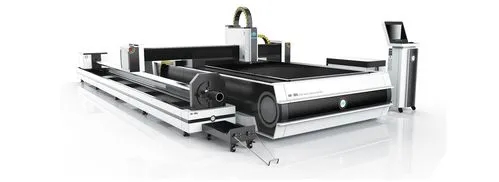In laser cutting machines, it is necessary to master and solve several key technologies to meet the requirements of cutting components with high accuracy or large thickness. Focus position control is one of them. One advantage of laser cutting is that the energy density of the beam is high, so the focal spot diameter is as small as possible to form a narrow slit. Because the focus lens has a smaller focal depth, the focal spot diameter will also be smaller. For high-quality cutting, the effective focus depth is also related to the lens diameter and the material being cut. Therefore, it is important to control the position of the focus relative to the surface of the material being cut.

Due to the significant impact of laser power density on cutting speed, the selection of lens focal length is an important issue. After the laser beam is focused, the spot size is proportional to the focal length of the lens. After the light beam is focused by a short focal length lens, the spot size is small, and the power density at the focal point is high, which is conducive to material cutting. However, its disadvantage is that the focus depth is very short and the adjustment margin is adjusted. Small size, generally suitable for high-speed cutting of thin materials. Due to the wide focal depth of a telephoto long lens, it is suitable for cutting thick workpieces as long as it has sufficient power density.
After determining which focal length lens to use, the relative position of the focus relative to the workpiece surface is particularly important to ensure cutting quality. Due to the high power density at the focus, in most cases, the focus position during cutting is only on or slightly below the surface of the workpiece. Ensuring a constant relative position of the focus and workpiece during the entire cutting process is an important condition for achieving stable cutting quality. Sometimes, due to poor cooling, the lens is heated and the focal length changes, which requires timely adjustment of the focus position.
Laser cutting machine
When the focal point is located in the appropriate position, the slit is small, the efficiency is high, and the cutting speed can achieve good cutting results. In most operational applications, the beam focus is adjusted below the nozzle. The distance between the nozzle and the workpiece surface is typically approximately 1.5 millimeters.
During laser applications, problems such as focusing often occur. There are three convenient methods to determine the focus position:
(1) Printing method: The cutting head moves from top to bottom and performs laser beam printing on a plastic plate, with a smaller diameter as the focus.
(2) Inclined plate method: Pull a plastic plate placed at an angle to the vertical axis horizontally to find a smaller portion of the laser beam as the focus.
(3) Blue spark method: Remove the nozzle, blow air, and apply a laser pulse to the stainless steel plate, moving the cutting head from top to bottom until the blue spark becomes larger.




